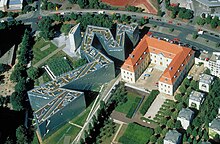Jewish Museum Berlin
| Jüdisches Museum Berlin | |
 | |
 The Kollegienhaus (1735) and Libeskind-Bau (1992) | |
| Established | 2001 |
|---|---|
| Location | Kreuzberg, Berlin, Germany |
| Coordinates | 52°30′07″N 13°23′42″E / 52.502°N 13.395°E |
| Type | Jewish museum |
| Director | Hetty Berg |
| Architect | Daniel Libeskind |
| Website | www |

The Jewish Museum Berlin (Jüdisches Museum Berlin) is a museum that shows the history of Jews in Germany from the Middle Ages to the present day. It is the largest Jewish museum in Europe, with two buildings and about 3,500 square meters (38,000 square feet) of space. It has a library and archives and holds lectures, concerts, and conferences. The W. Michael Blumenthal Academy of the Jewish Museum is connected to the museum. The museum is one of the most visited museums in Germany, with 2,000 visitors each day and 700,000 annually.
History[change | change source]
The first Jewish Museum in Berlin opened on January 24, 1933. This was six days before the Nazis took power. The building was on the Orienburger Straße next to New Synagogue. The museum was new because it showed modern Jewish art. The museum wanted to show that Jewish history was alive and part of German culture. The Nazis shut down the museum on Kristallnacht in November of 1938.[1]
A "Society for a Jewish Museum" was formed in 1976. A couple of years later, the Berlin museum added a Jewish Department. In 1988, the city had a competition for the building design of the museum. Daniel Libeskind won for his zigzag design structure. The building was completed in 1999, and the museum opened in September 2001. Michael Blumenthal was the first director of the museum until 2014.
Design[change | change source]
Buildings[change | change source]
The museum has two main buildings. One is the Kollegienhaus and is in baraque style. The other is a modern building by Libeskind. The modern building contains a unique zig-zag shape and is a form of deconstructivism. The architect wanted the building to address the Holocaust in Berlin's Jewish history.
Libeskind structure[change | change source]
There is much symbolism in the Libeskind structure. Empty voids fill the building. They represent "That which can never be exhibited when it comes to Jewish Berlin history: Humanity reduced to ashes."[2] Three Axes in the structure have particular significance. Each represents paths of Jewish life in Germany: continuity, emigration and the Holocaust. The second axis of the museum connects with the Garden of Exile. The third axis connects with the Holocaust Tower.
Exhibitions[change | change source]
Permanent exhibitions[change | change source]
The new permanent exhibition has five parts. It is called "Jewish Life in Germany: Past and Present". Each part is about a different period in Jewish history in Germany. The sections are Jewish life in Ashkenaz, the emancipation of the Jews, Englightenment, Natinalsocialism, and the present. The largest sections are for the time of National Socialism and after 1945. There are several rooms just for Judaism as a religion and religious art and music. There is further a tour with narration about culture and religion.
Two Millennia of German Jewish History[change | change source]
The past exhibition from 2001 to 2017 was "Two Millennia of German Jewish History". It showed history from the view of Jews as a minority. The exhibition included figures like Glikl bas Judah Leib and Moses Mendelssohn. The museum has had several special exhibitions. The most recent ones have been: Welcome to Jerusalem (2017-2019); Cherchez la femme (2017); Golem (2016-2017); Snip it! Stances on Ritual Circumcision (2014-2015); A Time for Everything. Rituals Against Forgetting (2013-2014).
Installations[change | change source]
Shalekhet – Fallen leaves[change | change source]
The museum has an installation called Shalekhet – Fallen leaves. It is a collection of 10,000 faces of metal plates in the Memory Void. Visitors are encouraged to walk on the metal and hear the sounds it makes. Menashe Kadishman dedicated his work to victims of the Holocaust, violence, and war.
The Gallery of the Mission[change | change source]
"The Gallery of the Mission" is another installation in the museum. It contains black mirrored glass cases which depict destroyed objects of Jewish culture. They are Encyclopaedia Judaica, Jewish hospital in Frankfurt, and the "Großer Kopf" sculpture by Otto Freundlich.
Prize for Understanding and Tolerance[change | change source]
The museum and Friends and Patrons of the Jewish Museum Berlin annually give out an award called Prize for Understanding and Tolerance. Past recipients include:
- 2002 – Berthold Beitz, Heinrich von Pierer
- 2003 – Otto Schily, Friede Springer
- 2004 – Michael Otto, Johannes Rau
- 2005 – Heinz Berggruen, Otto Graf Lambsdorff
- 2006 – Daniel Barenboim, Helmut Panke
- 2007 – Helmut Kohl, Fritz Stern
- 2008 – Roland Berger, Imre Kertész
- 2009 – Franz Fehrenbach and Christof Bosch (representing Bosch), Michael Verhoeven
- 2010 – Jan Philipp Reemtsma, Hubertus Erlen
- 2011 – Angela Merkel
- 2012 – Klaus Mangold, Richard von Weizsäcker
- 2013 – Berthold Leibinger, Iris Berben
- 2014 – Wolfgang Schäuble, Hubert Burda
- 2015 – W. Michael Blumenthal
- 2016 – Anita Lasker-Wallfisch and Renate Lasker-Harpprecht, Hasso Plattner
- 2017 – Joachim Gauck, Joe Kaeser
- 2018 – David Grossman, Susanne Klatten
- 2019 – Heiko Maas, Anselm Kiefer
- 2020 – Madeleine Albright, Igor Levit
References[change | change source]
- ↑ Brenner, Michael (1999). "Jewish Culture in Contemporary America and Weimar Germany: Parallels and Differences" (PDF). Central European University Jewish Studies Yearbook. 2 (2): 1–16.
- ↑ Daniel Libeskind - Jüdisches Museum Berlin, by Elke Dorner. Berlin: Gebr. Mann Verlag, 3. Auflage 2006; ISBN 3-7861-2532-5. (in German)
